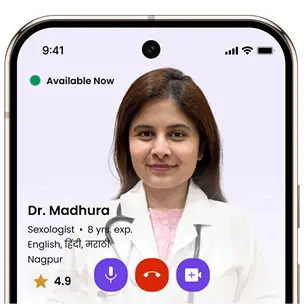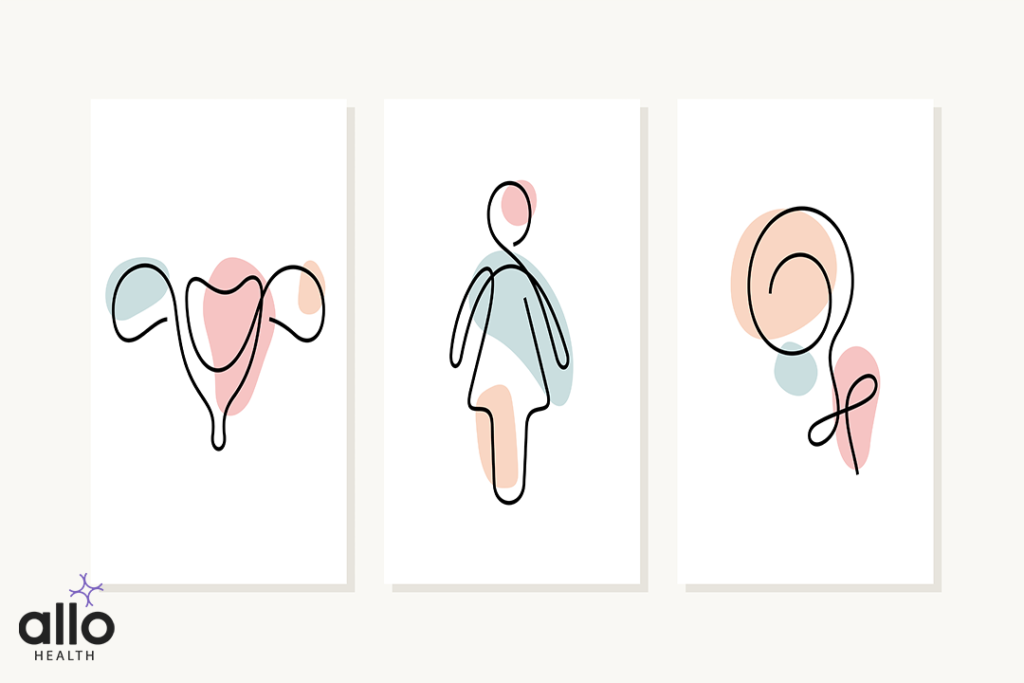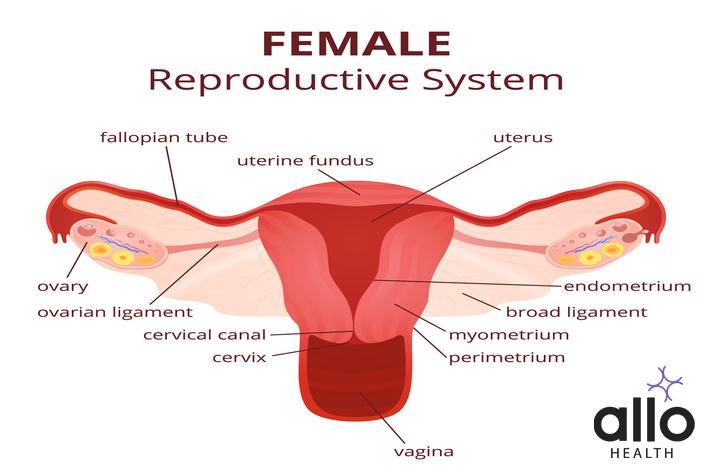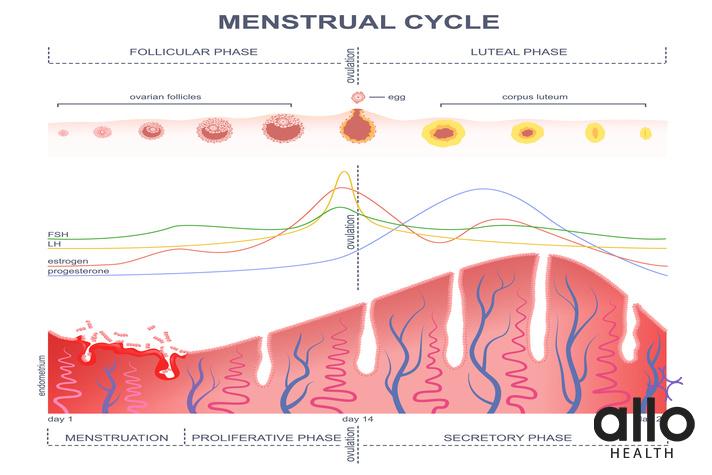Female Reproductive System
The female reproductive system consists of internal and external organs that enable reproduction, hormonal regulation, and sexual function. Key parts include the ovaries (which release eggs and hormones), fallopian tubes (where fertilization often occurs), uterus (supports pregnancy), vagina (birth canal and intercourse), and external genitalia (vulva). The menstrual cycle, controlled by hormones like estrogen and progesterone, prepares the body for pregnancy each month. If fertilization doesn’t occur, menstruation happens. Beyond reproduction, this system also influences bone health, mood, sexual wellness, and overall well-being. Common issues include PCOS, endometriosis, and fibroids. Regular check-ups help maintain reproductive health.
The female reproductive system is a complex, powerful, and essential component of overall health. Trying to understand how the female reproductive system works? Whether you’re a parent helping your child learn about puberty or someone exploring your reproductive health, this article has it all.
The female reproductive system is a system of internal and external organs that produces hormones, regulates menstruation and sexual activity, and plays a central role in fertility, reproduction, pregnancy, and childbirth by producing and releasing eggs, supporting fertilization, and nurturing fetal development.
Sounds so complicated, but it won’t once you go through our article.
Parts of the Female Reproductive System
Let’s explore the major parts of the reproductive system and what they do. The female reproductive system consists of the following parts
- Primary Sex Organ- Ovary
- Secondary Sex Organ-
- Supporting Ducts or pipes- Pair of oviducts (Fallopian tube), uterus, cervix and vagina
- Supporting Gland- Mammary Gland
- External Genetelia- Vulva
Primary Sex Organ
Ovaries
- Ovaries are the main female reproductive organs. They produce eggs and hormones like estrogen and progesterone. [1]
- Each woman has two ovaries, one on each side of the lower belly. They are almond-shaped and about 2–5 cm long.
- Inside the ovaries are tiny sacs called follicles. These hold immature eggs. When an egg matures, it is released during ovulation.
- The egg carries half the baby’s genes. When it joins with sperm, it can form a baby.
Secondary Sex Organs
Oviducts or Fallopian Tubes
- Fallopian tubes are two thin tubes, one on each side of the uterus. Each is about 10–12 cm long.
- They carry the egg from the ovary to the uterus.[2]
- The end of each tube has finger-like parts (fimbriae) that catch the egg after ovulation.
- The egg moves through the tube.
- Fertilization usually happens in the wide middle part of the tube (called the ampulla).
- The narrow end (isthmus) connects to the uterus.
- It is part of the female reproductive tract
Uterus (Womb)
- The uterus is a hollow, pear-shaped organ made of muscle.[3]
- It sits between the urinary bladder in the front (which stores urine) and the rectum at the back (the last portion of the digestive system).
- Its main job is to grow and protect a baby during pregnancy.
- The cervix is the lower part of the uterus. It connects to the vagina.
- Together, they form the birth canal.
The uterus has 3 layers:
- Perimetrium – Outer layer.
- Myometrium – Middle muscle layer; helps push the baby out.
- Endometrium – Inner layer; thickens for pregnancy and sheds during periods.
- Part of the female reproductive tract.
Mammary Gland
Breasts have mammary glands that make milk. They are made of:
- Glandular tissue, which is responsible for making milk
- Fatty tissue – Gives shape and softness
Each breast has 15–20 lobes with tiny sacs called alveoli that produce milk. Milk flows from alveoli → tubules → ducts → nipple during breastfeeding.
These mammary glands are present in the breast. Breast cancer [4] is common among females. Breast cancer occurs when breast cells mutate, in simple language means they develop and become cancerous cells that multiply and form tumors. Most breast cancer begins in the ducts.
Bartholin’s Gland
- The Bartholin glands are two tiny glands, about the size of a pea.
- They are located on each side of the vaginal opening, just inside the inner lips (labia minora).
- These glands produce a small amount of fluid to keep the vaginal area moist and comfortable.
- During sexual arousal, they release more fluid to act as a natural lubricant, making sex smoother and more comfortable.
- Although small and hidden, these glands play an important role in vaginal health.
- Sometimes, one of the glands can get blocked, causing a painless lump or cyst.
- If the cyst becomes painful or infected, it may need medical treatment.
External Genitalia (Vulva)
The vulva [5] is the name for the outer parts of the female reproductive system. It includes several parts that each have different roles:
- Mons Pubis: The soft, fatty area above the pubic bone, covered with pubic hair. It cushions and protects.
- Labia Majora: The outer skin folds that protect the vaginal area.
- Labia Minora: The inner skin folds just inside the labia majora.
- These folds surround the vestibule, which has:
- The urethral opening (where urine comes out), and
- The vaginal opening.
- Clitoris: A small, highly sensitive spot at the top where the labia minora meet. It’s important for sexual pleasure.
- Hymen: A thin tissue that may partly cover the vaginal opening. It can be torn naturally from sex, exercise, or movement.
The clitoris, labia, and vaginal opening all play roles in sexual pleasure.
Knowing your anatomy helps you understand your body better and improves communication with your partner.
Understanding this area is also important for protecting against STIs
- Use protection like condoms,
- Practice safe sex, and
- Visit a gynecologist regularly to stay healthy.
Note- The female reproductive system is also important in understanding how to protect yourself from sexually transmitted infections (STIs). Using protection like condoms, practicing safe sex, and regular gynaecological checkups can help maintain both reproductive and overall health.
Menstrual Cycle
- The menstrual cycle is the monthly change that happens in a woman’s body. [6]
- It prepares the body for pregnancy each month.
- The cycle usually lasts 28 to 29 days, but it can vary.
- Puberty starts around the ages of 9 to 13, which is when periods begin.
- The first period is called menarche.
- Periods continue until about age 50, when they stop—this is called menopause.
- The menstrual cycle involves changes in the uterus and ovaries, and ovarian hormones ( sex steroid hormones) and pituitary hormones (Luteinizing hormone and Follicle-Stimulating Hormone)
- It’s a normal part of growing up and shows that the body can reproduce.
- Knowing your cycle helps you track ovulation, manage symptoms, and spot health issues early.
The Menstrual Cycle Has 4 Main Phases:
- Menstrual Phase (Days 1–5)
- This is when your period happens.
- The uterus lining breaks down because there’s no pregnancy.
- Blood, tissue, and the unfertilized egg come out through the vagina.
- It usually lasts 3 to 5 days, but can vary.
- Follicular Phase (Days 6–14)
- After your period, your body prepares for the next pregnancy again.
- Tiny sacs in the ovaries called follicles start to grow in the follicular phase.
- One follicle matures and holds an egg.
- Sex Hormones, like the estrogen secreted by the ovary, rebuild the uterine lining.
- This phase lasts about 10 to 14 days.
- Ovulation or Ovulatory Phase (Around Day 14)
- A hormone ( Leutenising Hormone) surge triggers ovulation.
- The mature egg is released from the ovary.
- The egg travels into the fallopian tube.
- It may or may not meet the sperm and get fertilized.
- Ovulation lasts about 24 to 48 hours.
- Luteal Phase (Days 15–28)
- The empty follicle becomes the corpus luteum.
- It makes progesterone, which thickens the uterus lining.
- If there’s no pregnancy, progesterone drops.
- The lining starts to break down.
- This leads back to your next period, starting the cycle again.
What if Pregnancy Happens?
If pregnancy occurs, the menstrual cycle pauses. The fertilized egg implants in the uterus, and hormones prevent further ovulation. If no pregnancy happens, the cycle repeats. Around age 50, menopause marks the end of menstruation as hormone levels decline
Menopause [7]- Around the age of 50, the menstrual cycle naturally ends, and periods stop completely. This stage is called menopause, and it marks the end of a woman’s reproductive years.
Functions of the Female Reproductive System
Before diving into the anatomy, which is the internal structure, let’s first understand how the female reproductive system plays a major role in the human body.
- Formation of Female – Ovaries are the primary organ that produces chemicals called hormones (estrogen and progesterone) that control menstruation (commonly called periods), pregnancy, and other female body changes.
- Releases the female gamete (Ovulation)- The ovaries release an egg or the female reproductive cell, or female gametes, each month, which is needed for pregnancy.
- Fertilization- It provides a place for the egg and sperm (male reproductive cell) to meet, which is called fertilization, usually in the fallopian tubes.
- Pregnancy- If the egg is fertilized, it grows in the uterus, causing pregnancy, which provides a safe place for the baby to develop.
- Childbirth- During birth, the baby passes through the vagina ( a structure of the female reproductive system), which is part of the birth canal.
- Menstruation- If the egg isn’t fertilized, the blood in the uterus is shed, causing menstruation, commonly called periods.
- Sexual activity- It includes parts that allow for sexual pleasure and reproduction.
How does the Female Reproductive System affect overall health?
The female reproductive system does much more than just allow for pregnancy or childbirth.
It plays a major role in a woman’s overall health and well-being—physically, emotionally, and hormonally. These organs work together to regulate hormones, support fertility, and maintain reproductive and sexual health. Let’s understand them in detail.
|
Function |
Details |
|
Hormone Balance |
The ovaries produce important hormones like estrogen and progesterone. These hormones help control periods, mood, energy levels, and even skin health. When hormone levels change, it can cause symptoms like acne, weight gain, or even mood swings. |
|
Bone and Heart Health |
When the estrogen levels drop after menopause or may even drop due to some condition in a female, it starts affecting the bone and heart health. Estrogen keeps the bones strong and the heart healthy. |
|
Mental and Emotional Well-being |
Hormonal changes during the menstrual cycle, pregnancy, or menopause can affect mood. Some women feel irritable, anxious, or depressed at certain times. |
|
Sexual Health and Comfort |
A healthy reproductive system helps with pleasure and comfort during sex. Issues like dryness, pain, or infections can affect both health and relationships. |
|
Periods (Menstrual) Health |
Regular periods are a sign that the body is working well. Irregular or painful periods might be a sign of hormonal problems, stress, or conditions like PCOS or endometriosis. |
|
Fertility and Pregnancy |
The reproductive system affects a woman’s ability to get pregnant and carry a baby. Problems in this system can lead to infertility or pregnancy complications. |
Common Conditions That Affect the Female Reproductive System
The female reproductive system can be affected by a variety of health conditions, some of which are quite common. Understanding these conditions can help you recognise symptoms early, seek timely care, and take better control of your reproductive health. Here are a few you should know about:
- PCOS (Polycystic Ovarian Syndrome)[8]: A hormonal condition where the ovaries make too many male hormones (androgens) and don’t release eggs regularly, which can cause irregular periods and make it harder to get pregnant.
- Endometriosis [9]: A condition where tissue that normally lines the uterus starts growing outside of it, leading to pain and sometimes trouble getting pregnant.
- Uterine Fibroids: Non-cancerous growths in the uterus that can cause heavy periods or pelvic pain.
- STIs and Vaginal Infections: Conditions like chlamydia, yeast infections, or bacterial vaginosis can affect vaginal health and cause discharge, itching, or pain.
Conditions like PCOS, endometriosis, or fibroids are common, but they’re not normal. Early diagnosis and treatment can make a significant difference in quality of life and fertility outcomes.”
If you notice any unusual symptoms or changes in your menstrual cycle, it’s important to talk to a healthcare provider. Early diagnosis and proper treatment can help manage these conditions effectively and support your overall reproductive health.
When to See a Doctor
You should consult a healthcare provider if you experience:
- Irregular or missed periods
- Pain during sex or menstruation
- Unusual vaginal discharge or bleeding
- Difficulty conceiving
- Signs of infection (itching, burning, or odour)
Routine gynaecological check-ups can help you stay on top of your reproductive health.
"The following blog article provides general information and insights on various topics. However, it is important to note that the information presented is not intended as professional advice in any specific field or area. The content of this blog is for general educational and informational purposes only.
Book consultation
The content should not be interpreted as endorsement, recommendation, or guarantee of any product, service, or information mentioned. Readers are solely responsible for the decisions and actions they take based on the information provided in this blog. It is essential to exercise individual judgment, critical thinking, and personal responsibility when applying or implementing any information or suggestions discussed in the blog."










